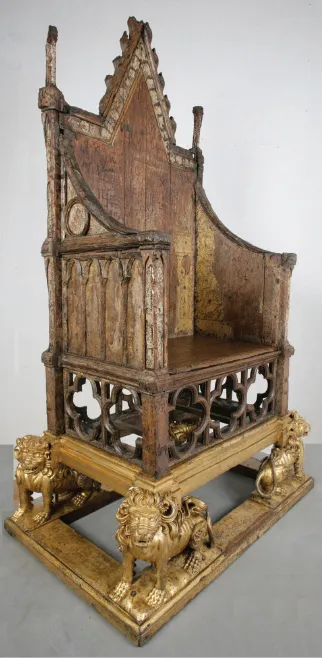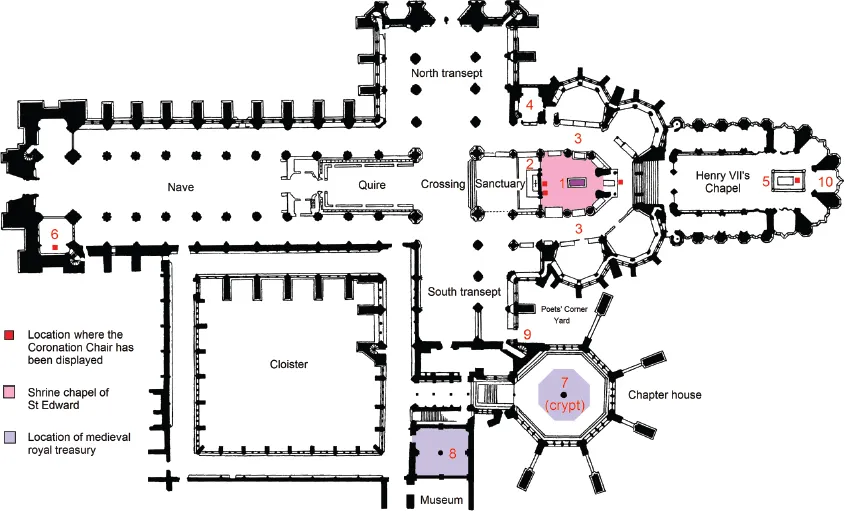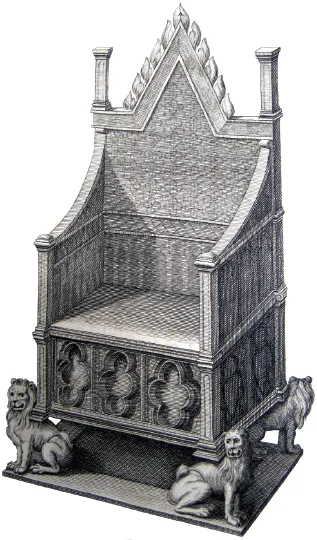![]()
1
Historiography of the Chair and the Stone
‘. . . that chair where Kings and Queens are crowned’
(William Shakespeare, King Henry VI, Part 2, Act 1:2)
Prologue
St Edward’s Chair – popularly known today as the Coronation Chair – is unique as a surviving piece of English medieval furniture with a documented history which begins in the closing years of the thirteenth century. It is not a museum object, but remains periodically in use in Westminster Abbey. With a few exceptions, English monarchs since the fourteenth century have been anointed and crowned in the Chair, before the high altar. Not surprisingly, the medieval records are meagre, and pictorial representations prior to the eighteenth century are few, with the consequence that there are lacunae in our knowledge. Some of these can be filled through archaeological and scientific study, while others will always remain.
There are two interwoven strands to the history of the Coronation Chair: the ornately decorated wooden chair itself, and the block of Scottish sandstone that it was designed to encapsulate within the seat compartment. The Stone of Scone (also known as the Stone of Destiny), was captured by King Edward I in the Scottish Wars of Independence and brought back to Westminster. It provided the raison d’être for the construction of the Chair, which began in 1297 and was finished by 1300.
Today, the Coronation Chair stands 2.05 m (6 ft 9 ins) high and comprises a medieval moulded oak frame, which was once richly embellished with gilding, foliate decoration, painting, imitation enamels and glass inlays. The original base having long been lost, it is now supported on a Georgian gilt-wood plinth which prominently incorporates four carved lions (Fig. 1).1 For coronations from the later Middle Ages until 1838, it was customary to mask the Chair’s worn and damaged state by swathing it in rich textiles. The fabric was usually nailed to the framework, splitting the timber and causing considerable disfigurement. Moreover, during the eighteenth and early nineteenth centuries, the Chair was regarded primarily as an object of antiquarian curiosity, and was not treated with due respect: graffiti were prolifically carved in the timber, and souvenirs taken.
1 The Coronation Chair after conservation, 2012. Chris Titmus, © Dean and Chapter of Westminster
The Chair has spent most of its life in the Abbey’s shrine, the chapel of St Edward the Confessor, but has latterly been displayed at other, more accessible locations within the building; in 2010−12 it was temporarily displayed in St George’s Chapel whilst undergoing conservation (Fig. 2). A permanent setting for the Chair has now been created in that chapel (Fig. 328). Since 1996, the compartment under the seat, where the Stone rested for seven centuries, has been empty, the Stone itself being on loan to Scotland. It is currently displayed, along with Scottish regalia, in the Crown Room at Edinburgh Castle (Figs 3 and 270).2 The Stone will be returned to the Chair for all future coronations.
Antiquarian interest, c. 1560−1850
The Coronation Chairs
Medieval references to the Chair and Stone are few, and will be examined in the next chapter. However, after c. 1560, with the rise of antiquarianism, there is a steady increase in the material available to scholars. We begin with William Camden, one of Britain’s earliest and best-known antiquaries, and Westminster Abbey’s first librarian. He was familiar with the Abbey from at least 1575, when he was appointed Second Master at Westminster School. In 1600, he wrote the first guidebook to the Abbey, and in his description of the Solium Regni Scotici (‘Stone of the Scottish kings’), he referred to it dismissively as ‘the Stone of Jacob, as they call it’:
Solium Regni Scotici. Rex Edwardus Primus cum devictis Scotis triumphator 1297. rediisset sceptrum & coronam Regum Scotiae, unà cum folio in quo Scotorum Reges inaugurari solebant in Ecclesia Westmonasteriensi Deo obtulit. Quod quidem solium adhuc in hac Regia Capella seruatur cum Saxo Iacobi, ut vocant, imposito, & tabella pensili cum his versis.3
Camden then quoted the text that was written on a tablet placed on or beside the Chair:
Si quid habent veri vel chronica, cana fidesue, Clauditur hac cathedra nobilis ecce lapis. Ad caput eximius Iacob quondam Patriacha Quem posuit cernens numina mira poli; Quem tulit ex Scotis spolians quasi victor honoris, Edwardus Primus, Mars velut armipotens, Scotorum domitor, noster validissimus Hector, Anglorum decus, & gloria militiae.
Richard Bentley loosely translated the text as follows:
That if any faith is to be given to ancient Chronicles, a stone of great Note is enclosed in this Chair, being the same on which the Patriarch Jacob reposed when he beheld the miraculous descent of Angels. Edward I, the Mars and Hector of England, having conquered Scotland, brought it from thence.4
German travellers were particularly assiduous in keeping journals, and one of the earliest recorded visitors to the Abbey was Lupold von Wedel, in 1584−85, who remarked on the Chair and Stone.5 Another, Samuel Kiechel, also visited and commented in 1585.6 Both claimed that they saw the Chair in the ‘quire’ but, like some other early writers, were probably unfamiliar with the precise ecclesiastical nomenclature in use at the Abbey: it is likely from the context that they all meant the shrine chapel, and not the quire or sanctuary.7 There is no evidence to suggest that the Coronation Chair was ever displayed outside St Edward’s Chapel until 1998.8 In 1592, Frederick, Duke of Württemberg, visited the Abbey, and in 1598, Paul Hentzner, a German lawyer, noted in the account of his travels that near to the Coronation Chair was a Latin inscription, which he copied down. In the following year, a Swiss physician and tourist, Thomas Platter, similarly recorded his visit to the Abbey.9
As we move into the seventeenth century, more English descriptions become available. In his treatise, Ancient Funerall Monuments (1631), John Weever did not describe the Chair or Stone, but cited the mythical history of the latter, and reproduced several literary allusions to it, including John Hardyng’s, c. 1465 (p. 17).10
The earliest physical description of the Stone to incorporate archaeologically useful detail is by Henry Keepe, in his Monumenta Westmonasteriensia (1682). He informs us that the Chair stood in St Edward’s Chapel against the back of the altar screen, facing east, and that
2 (opposite) Ground plan of Westminster Abbey, showing the principal features and locations referred to in the text. Key: 1, Shrine and tomb of St Edward the Confessor; 2, High altar; 3, Ambulatory; 4, Abbot Islip’s Chapel; 5, Enclosure grille and tomb of Henry VII; 6, St George’s Chapel; 7, Crypt beneath the chapter house; 8, Pyx chamber; 9, Door from the south transept to Poets’ Corner yard; 10, RAF Chapel. Warwick Rodwell, © Dean and Chapter of Westminster
3 The Stone of Scone displayed in Edinburgh Castle. View from the front right. © Crown copyright, reproduced courtesy of Historic Scotland
4 The earliest engraved illustration of the Coronation Chair. The gilt punch-work on the interior has been rationalized, omitting the seated figure of a king on the back. Sandford 1687
. . . it appears extremely ancient both in its fashion and materials, being made of solid, hard, firm wood, with a back and sides of the same, under whose Seat, supported by four Lions curiously carved insteed (sic) of feet, lies that so much famed stone whereupon the Patriarch Jacob is said to have reposed his head in the Plain of Luza. It is of a blewish steel-like colour, mix’d with some eyes of red, triangular rather than any other form, and being broken resembles a Peble. The ruines of the Chair itself show that heretofore it hath been fairly painted, and gilt with Gold, but at present it is much defaced; you...





